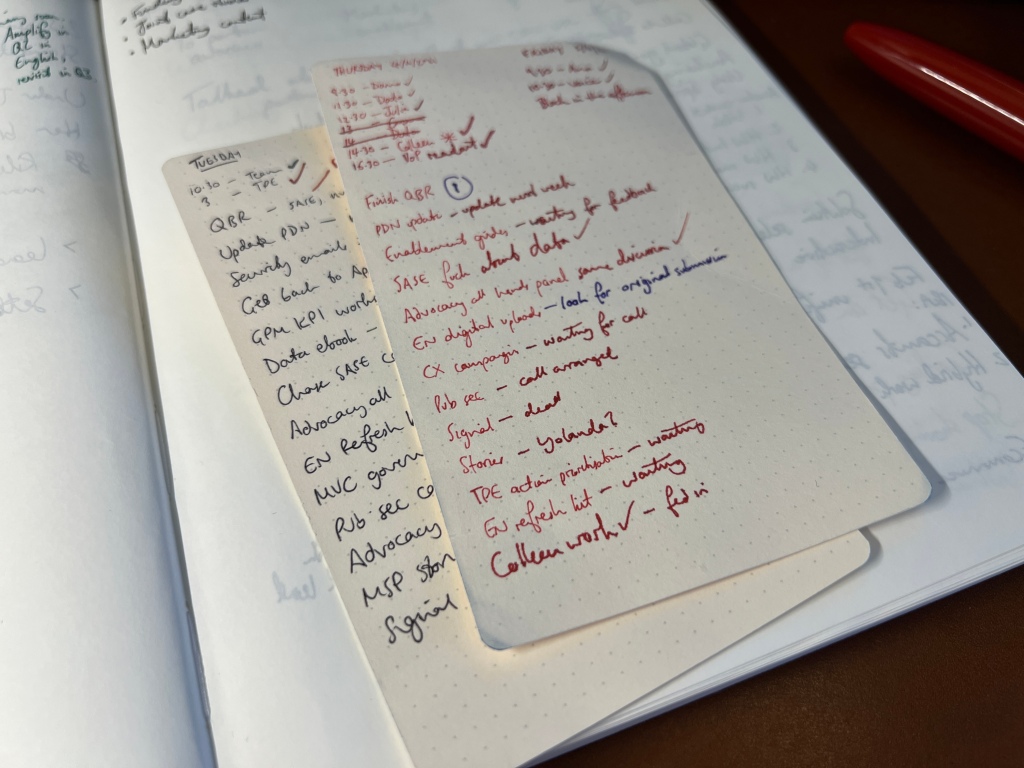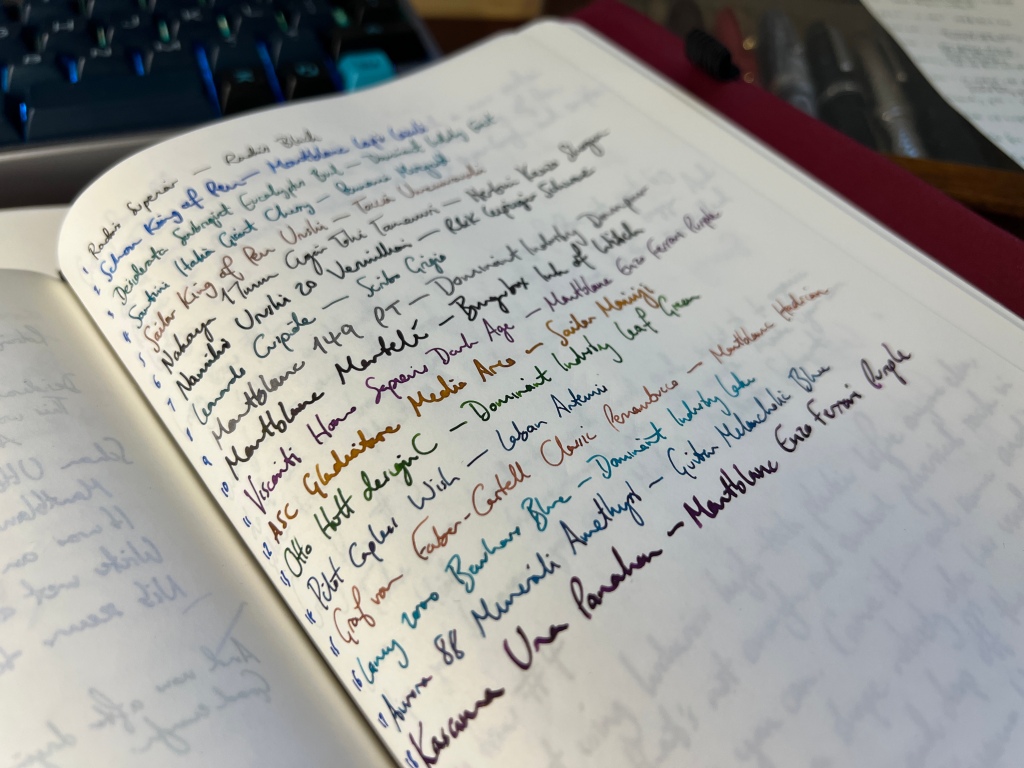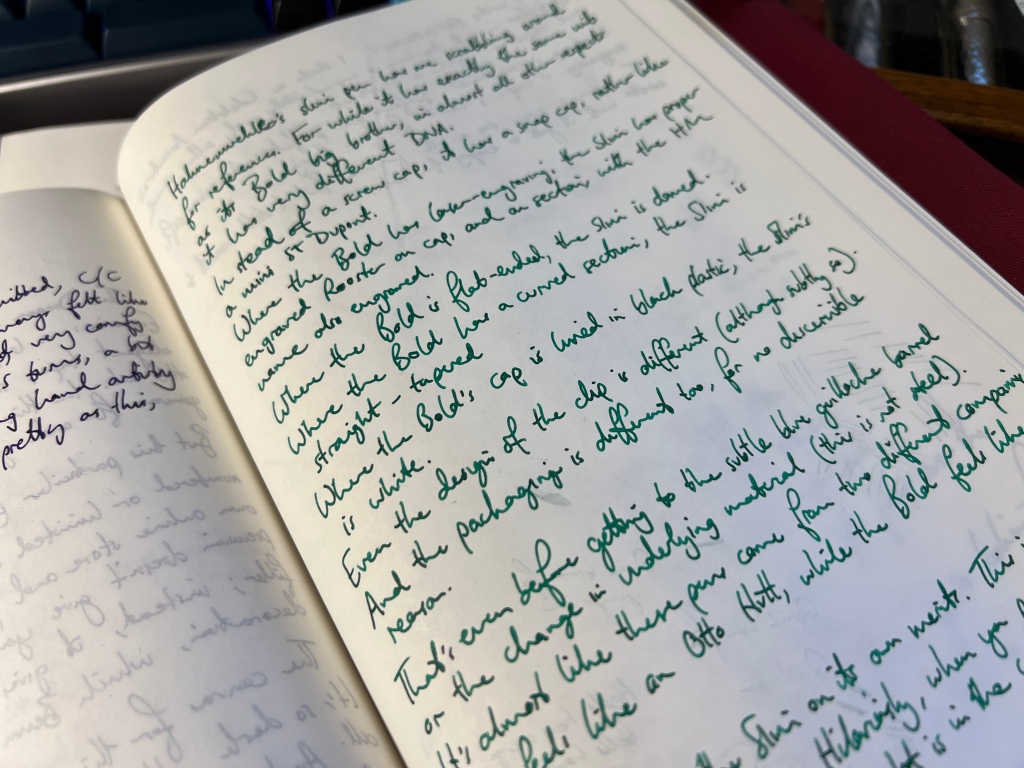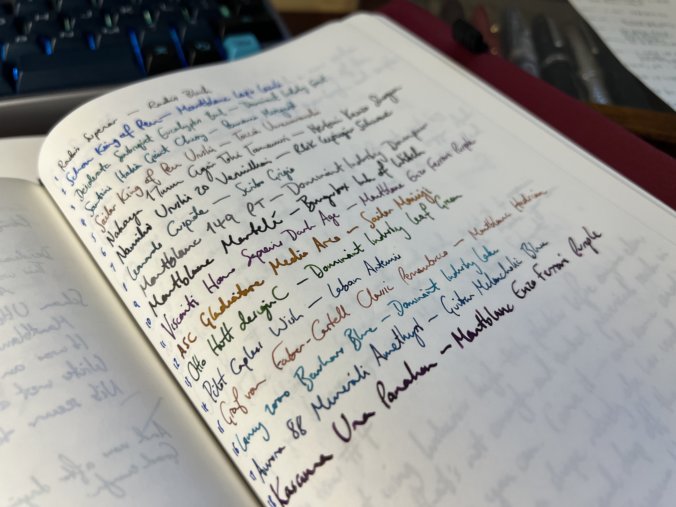I have never been proud of my handwriting. It’s better than it was, years ago: I have fountain pens to thank for that, more than conscious effort. Regardless of cause, I certainly see more pleasing flourishes than in years past, more balanced letter shapes, more proportion to my ascenders and descenders.
But that doesn’t mean I like the way it looks, and I still hide it away. This is a purely aesthetic concern; I don’t buy into the junk science of graphology — my dodgy handwriting doesn’t say anything about my personality or mental state, although my choice of words might! Nevertheless, you’ll see precious few photos of my handwriting on Instagram, and I’ll always have a pang of envy when I see posts from those with a recognisable, naturally confident hand.
Luckily, handwriting is not a social act for me. I don’t much write letters or postcards, or even Christmas and birthday cards (and that’s purely down to laziness and poor planning — I have the best of intentions every year). I no longer mark up drafts by hand to share back with my team, with dense scribbles in the margin of their printouts. I’m not a professional letterer or a doctor writing prescriptions.
No: my writing is just for me.
Handwriting means first and foremost my nightly journal, which has become a kind of cleansing ritual, where I dump my boring day, every routine act, on to the page.
I do so without judgement, editing, ordering or processing, with the most important event barely granted more space than the most mundane.
I’m not writing to impress a future reader, because I have no delusions that my life is historic or my observations are noteworthy. Eventually, these books will end up in a skip, not in a library. Nor do I read back old diaries myself, at least not yet. If the urge ever strikes, my steadily growing stack of journals waits in my loft.
Really, it’s the act of writing them that matters. The flow of words over the page, fluid like a long-distance runner who’s settled into his stride (in a sense, my favourite pens are those that get me into this flow state most consistently).
I average a page, two pages of A5 per night. I’m picky about my paper: while I might experiment with variety for my work notebooks, for my journals it’s Tomoe River, A5, softcover; from Galen or Elia or Musubi or Sakae or Nanami or Taroko, ideally 7mm lines, the words packed on the page by a fine nib, swapping pens every few paragraphs for the joy of a different ink on the paper.

Some pens make my journal pages look better than others. Visconti’s long tines — like on the Homo Sapiens Dark Age I bought recently from Cult Pens — give me a little extra flourish, while its wet yet narrow lines ensure crisp and saturated letter forms. Fatter nibs, even italics, sadly make my words blob together.

Journalling is often my treat to enjoy the feeling of shaping words with my more luxurious pens. My Nakaya with soft medium nib gives a fun bounce and scribbly tooth. The weighty Martele or designC give a consistent hand and make me feel the pen is doing the work for me. But I have to say that right now it’s the soft nib on the incredibly comfortable Sailor King of Pen that really makes me want to keep writing. For the hypnotic flow of journalling, that would be my desert island pick.
Beyond my journal, handwriting to me means my work notes, the drafts of ideas that take shape on paper before they leap to the screen for refining and sharing.
Sometimes these appear as pages of proper prose, sometimes mind maps or bulleted lists, scribbled out, added to, connected by arrows or grouped by circles, punctuated by exclamation points and underlining when my brain leaps upon a fresh idea that later seems so obvious or even meaningless.

Flicking back through these pages I can sometimes vividly recall the moment I wrote them, the sense of triumph at a problem solved, the joy of creation. A spark of life lurks in those colourful lines.
Often for these punctuated bouts of frenetic creativity I want a pen that helps me shape my words precisely. The slim and well balanced Graf Classic always feels controlled as my mind darts about, and its fine line helps me cram ideas on a single A5 page without losing coherence.
Tucked inside my work notebook are the daily to-do lists on index cards that keep my week moving forward and help me make sense of the chaos. I review these at the end of the week, exasperated to find so few items ticked off, or proud of what I’ve accomplished. Sometimes Monday seems so long ago that if I didn’t have the list to refer to, I wouldn’t have a clue what I’d been working on just a few days prior. I depend on these cards as much as on my morning coffee.

My lists are always long and my cards are always small, so the finer the nib the better here. My Lamy 2000 in EF, Radius Superior in EF or Capless in F often get called to duty. In these lists my handwriting gets stripped back, flourishes disappearing and letter forms simplifying lest the essential item gets lost in a tangle of cursive. The words themselves are minimised too, often just a verb paired with a name, acronym or term — “review SASE”, “finish pubsec deck”, “reply to Nicole”. Even if you could decode the letters, the words remain meaningless.
And lastly in the world of work, there are the barely coherent meeting notes that fill up page after page, serving as evidence of commitments made (and sometimes defaulted on) but more helping me stay focused and process what’s being said, as it’s being said.
These notes are often surrounded by doodles: 3D geometric designs, paisley swirls, dots and lines, patterns of shading. They spring up like mushrooms, organically, spreading faster when the meeting runs slower.

These are my opportunities to use my more flamboyant pens and nibs, like my Kasama with stub nib. They let me break off from the doodles to scribble big scrappy letters whenever the moment strikes.

As a pen collector, there’s one more occasion for handwriting: the regular litany of my Currently Inked lists, and hundreds of quick brown foxes reporting back about how successfully I’ve tuned my latest nib, how much I like the latest ink. I run down these pangrams half mindfully, half automatically , like a devout passes over the beads of a rosary, every repetition a step towards inner peace. Here every pen waits its turn patiently.

And of course as a pen blogger handwriting is an activity I do intently, just for the perception of the process itself. I write pages to capture my thoughts on the pen in my hand, paying close attention to how it feels in my fingers, how the nib feels on the page.

So in a sense, just like the pens that produce it, handwriting means many things to me: cathartic personal expression, professional output, enthusiast hobby.
Handwriting may mean these things to you too, or maybe many other things that I’ve not mentioned. In my survey last year, I discovered that people use pens, and therefore handwriting, for all kinds of things.
Regardless of what we do with our handwriting, what matters is that we practice it, daily. Why? Well, from the perspective of a pen addict, I feel something is deeply wrong when my pens are sitting unused. But from a more human perspective, there’s plenty of evidence that handwriting helps us. It improves comprehension and retention of ideas when we’re learning. It can help concentration when we’re listening through the act of doodling. And handwriting (or journalling more generally) can also improve our mental wellbeing. There are studies covering all of these topics, but I’m sure you’ve felt this personally; I know I have. When events conspire and I miss a day of journalling, I feel anxious, a little lost, until I can catch up and find my place in my personal narrative.
So as we head towards national handwriting day, and InCoWriMo, let’s take a minute to appreciate this most uniquely human and timeless act, the many ways it brings joy and value to our lives — and the special role our pens play in making the magic happen.

As a fellow sidewriting leftie, I sometimes like to use vintage OB and stub nibs to give some flourish to my scribbles.
Funny how I’m reading this on a day where I have been especially frustrated with my own handwriting. Specifically how I can like my handwriting with certain pens and absolutely hate it with others. Much appreciated posting!
I love handwriting..what a beautiful art that will soon be lost.. I usually just write on anything with anything.. preferring Gel pens..however my son gave me a Mont Blanc pen for Christmas!! What a joy..
My grandchildren can’t read my handwriting ( they have to have my sons
help them or read them over and over) but hang on to every note and letter they receive ! They save it to show their children..fortunately that is one thing I still have since 4th grade beautiful handwriting!
This is your finest essay yet, and I say essay because you should be considered an essayist on stationery rather than a pen blogger. The novelist Philip Hensher wrote up his thoughts on handwriting in book form as “The Missing Ink”. I think you should publish a collection of your essays in book form too.
I’ve ordered it — thanks for the recommendation! And thank you so much for the compliment, Sayandev. Possibly the highest I’ve received, and I’m honoured.